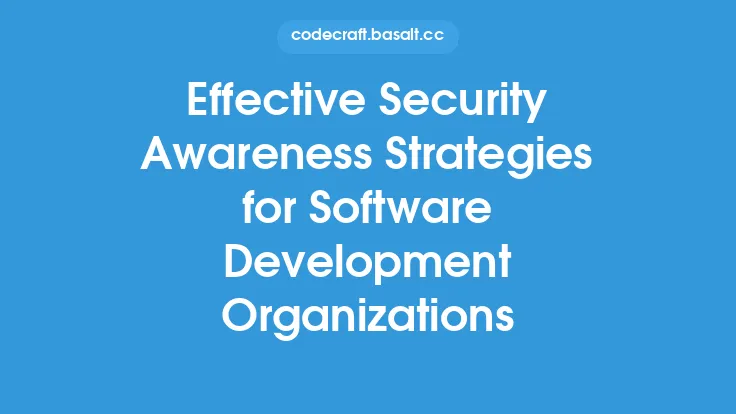The software development lifecycle (SDLC) is a complex process that involves multiple stages, from planning and design to development, testing, and deployment. Security awareness plays a critical role in each of these stages, as it helps ensure that the software being developed is secure, reliable, and meets the required standards. In this article, we will explore the impact of security awareness on the software development lifecycle, highlighting its importance, benefits, and best practices.
Introduction to Security Awareness in SDLC
Security awareness in SDLC refers to the knowledge and practices that developers, testers, and other stakeholders have to identify and mitigate potential security risks and vulnerabilities in the software. It involves understanding the security requirements, threats, and risks associated with the software, as well as the measures to prevent, detect, and respond to security incidents. Security awareness is essential in SDLC because it helps prevent security breaches, protects sensitive data, and ensures compliance with regulatory requirements.
Security Awareness in the Planning Phase
In the planning phase of SDLC, security awareness is critical in defining the security requirements and objectives of the software. This involves identifying the potential security risks and threats, as well as the measures to mitigate them. Developers and stakeholders must consider factors such as data encryption, access control, authentication, and authorization to ensure that the software meets the required security standards. Security awareness in the planning phase helps prevent security vulnerabilities and ensures that the software is designed with security in mind.
Security Awareness in the Design Phase
In the design phase of SDLC, security awareness is essential in creating a secure architecture and design for the software. This involves considering factors such as secure coding practices, input validation, error handling, and secure data storage. Developers must also consider the security implications of third-party components, libraries, and frameworks used in the software. Security awareness in the design phase helps prevent security vulnerabilities and ensures that the software is designed with security in mind.
Security Awareness in the Development Phase
In the development phase of SDLC, security awareness is critical in implementing secure coding practices and preventing security vulnerabilities. This involves using secure coding techniques, such as secure input validation, secure error handling, and secure data storage. Developers must also use secure coding tools and frameworks, such as static analysis tools and secure coding libraries, to identify and prevent security vulnerabilities. Security awareness in the development phase helps prevent security breaches and ensures that the software is secure and reliable.
Security Awareness in the Testing Phase
In the testing phase of SDLC, security awareness is essential in identifying and mitigating potential security risks and vulnerabilities. This involves performing security testing, such as penetration testing, vulnerability scanning, and security auditing, to identify security weaknesses and vulnerabilities. Testers must also consider factors such as secure testing practices, test data management, and test environment security to ensure that the testing process is secure and reliable. Security awareness in the testing phase helps identify and mitigate security risks and ensures that the software is secure and reliable.
Security Awareness in the Deployment Phase
In the deployment phase of SDLC, security awareness is critical in ensuring that the software is deployed securely and meets the required security standards. This involves considering factors such as secure deployment practices, secure configuration, and secure data transfer. Developers and stakeholders must also ensure that the software is deployed in a secure environment, with adequate security controls and measures in place to prevent security breaches. Security awareness in the deployment phase helps prevent security breaches and ensures that the software is secure and reliable.
Benefits of Security Awareness in SDLC
The benefits of security awareness in SDLC are numerous and significant. Some of the key benefits include:
- Improved security: Security awareness helps prevent security breaches and ensures that the software is secure and reliable.
- Reduced risk: Security awareness helps identify and mitigate potential security risks and vulnerabilities, reducing the risk of security breaches.
- Compliance: Security awareness helps ensure compliance with regulatory requirements and industry standards.
- Cost savings: Security awareness helps prevent security breaches, which can be costly to remediate.
- Reputation: Security awareness helps protect the reputation of the organization by preventing security breaches and ensuring that the software is secure and reliable.
Best Practices for Security Awareness in SDLC
Some best practices for security awareness in SDLC include:
- Provide security awareness training to developers, testers, and other stakeholders.
- Integrate security awareness into the SDLC process.
- Use secure coding practices and tools.
- Perform security testing and vulnerability scanning.
- Ensure compliance with regulatory requirements and industry standards.
- Continuously monitor and evaluate the security of the software.
Conclusion
In conclusion, security awareness plays a critical role in the software development lifecycle. It helps prevent security breaches, protects sensitive data, and ensures compliance with regulatory requirements. By integrating security awareness into the SDLC process, developers and stakeholders can ensure that the software is secure, reliable, and meets the required standards. The benefits of security awareness in SDLC are numerous and significant, and best practices such as security awareness training, secure coding practices, and security testing can help ensure the security and reliability of the software.





